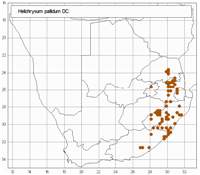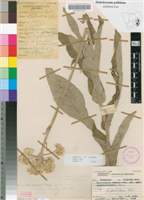Common names:
Boleba, bolebatsi, papetloane-ea-thaba (SS)
Origin of name:
pallidum = rather pale
Diagnostic characters:
Pale yellow bractsLarge flower headsCompact branched inflorescenceLarge sessile leaves
Description:
Perennial herb, rootstock stout, woody, roots producing narrow tubers, flowering stem usually solitary, up to 650 mm tall, often much shorter, leafy in lower half becoming pedunculoid upwards, thinly woolly. Radical leaves up to 400 x 120 mm, up to ? of the length petiolar, blade broadly to narrowly elliptic, gradually contracted to the long, flat petiole-like base, expanded and clasping below, apex acute to acuminate, margins often undulate, upper surface harshly pubescent, sometimes lightly cobwebby at first, lower thinly greyish-white felted, 5�7-nerved, tertiary nerves scalariform, raised or not, but clearly visible; cauline leaves similar, becoming sessile and cordate-clasping upwards and passing into distant bracts. Heads homogamous, campanulate, c. 6�7 mm long and as broad, many in a compact, flat-topped corymb. Involucral bracts in c. 4 series, subequal, closely imbricate, equaling the flowers, backs woolly, tips ovate, subobtuse, creamy to pale yellow, sometimes washed palest brown, more or less opaque, scarcely radiating. Receptacle with fimbrils at least equaling the ovaries. Flowers 18�34. Achenes not seen, ovaries glabrous. Pappus bristles many, scabrid, bases lightly fused.
Flowering between August and February.
Distribution:
Grows in grassland. Ranges from the eastern highlands of Limpopo and Mpumalanga and neighbouring Swaziland to KwaZulu-Natal (sea level to c. 2 700 m), the NE. part of the Free State and nearby parts of Lesotho, Transkei and E. Cape as far as East London and the Amatola Mountains, Katberg, Boschberg and the Suurberg N. of Port Elizabeth.
Grassland Biome.
Notes:
At higher altitudes, the radical leaves of H. pallidum tend to be lanceolate-elliptic; at lower altitudes they tend to be ovate-elliptic, more like those of H. nudifolium var. oxyphyllum, and some specimens are difficult to place. It may be significant that difficulty arises when the two species are sympatric.Taxonomy:
Literature:
Helichrysum pallidum DC., Prodr. 6: 199 (1838); Hilliard & Burtt in Notes R. bot. Gdn Edinb. 32: 355 (1973); Compton, Fl. Swaziland 633 (1976); Hilliard, Compositae in Natal 180 (1977).
Type:
Eastern Cape, between the Umzimkulu and Umtentu Rivers, Dr�ge 5008 (G-DC, holo.; BM, iso.; H. pallidum var. ellipticum DC.).
Synonym(s):
Gnaphalium pallens Sch. Bip. in Bot. Ztg 3: 171 (1845). H. undatum var. pallidum (DC.) Harv. in F.C. 3: 238 (1865).
H. pallidum DC. var. intermedium DC., Prodr. 6: 199 (1838). Lectotype: Cape, between the Kei and Buffalo Rivers, Dr�ge 3746 (G-DC; BM, isolecto.).
H. pallidum DC. var. longifolium DC., Prodr. 6: 199 (1838). Lectotype: Cape, Kat River Mts, Dr�ge 3746 (G-DC).
H. agrostophilum Klatt in Bull. Herbarium Boissier 4: 833 (1896) p.p. H. undatum var. agrostophilum (Klatt) Moeser in Bot. Jb. 44: 270 (1910). Lectotype: Mpumalanga, Barberton, Saddleback Mountain, Galpin 703 (Z; BOL; K; NH, isolecto.).
H. agrostophilum var. nemorosum H. Bol. in Trans. S. Afr. phil. Soc. 18: 393 (1907). Type: Limpopo Province, Pietersburg distr., Houtbosch, c. 1 500 m, Feb., Bolus 10991 (BOL, holo.; K, iso.).
Vouchers:
Hilliard 1748 (NU); Hilliard 5015 (E; K; NH; NU); MacOwan 1681 (SAM); Wright 402 (E; NH; NU).

_sml.jpg)
_sml.jpg)
_sml.jpg)
_sml.jpg)
_sml.jpg)
_sml.jpg)
_sml.jpg)
_sml.jpg)
